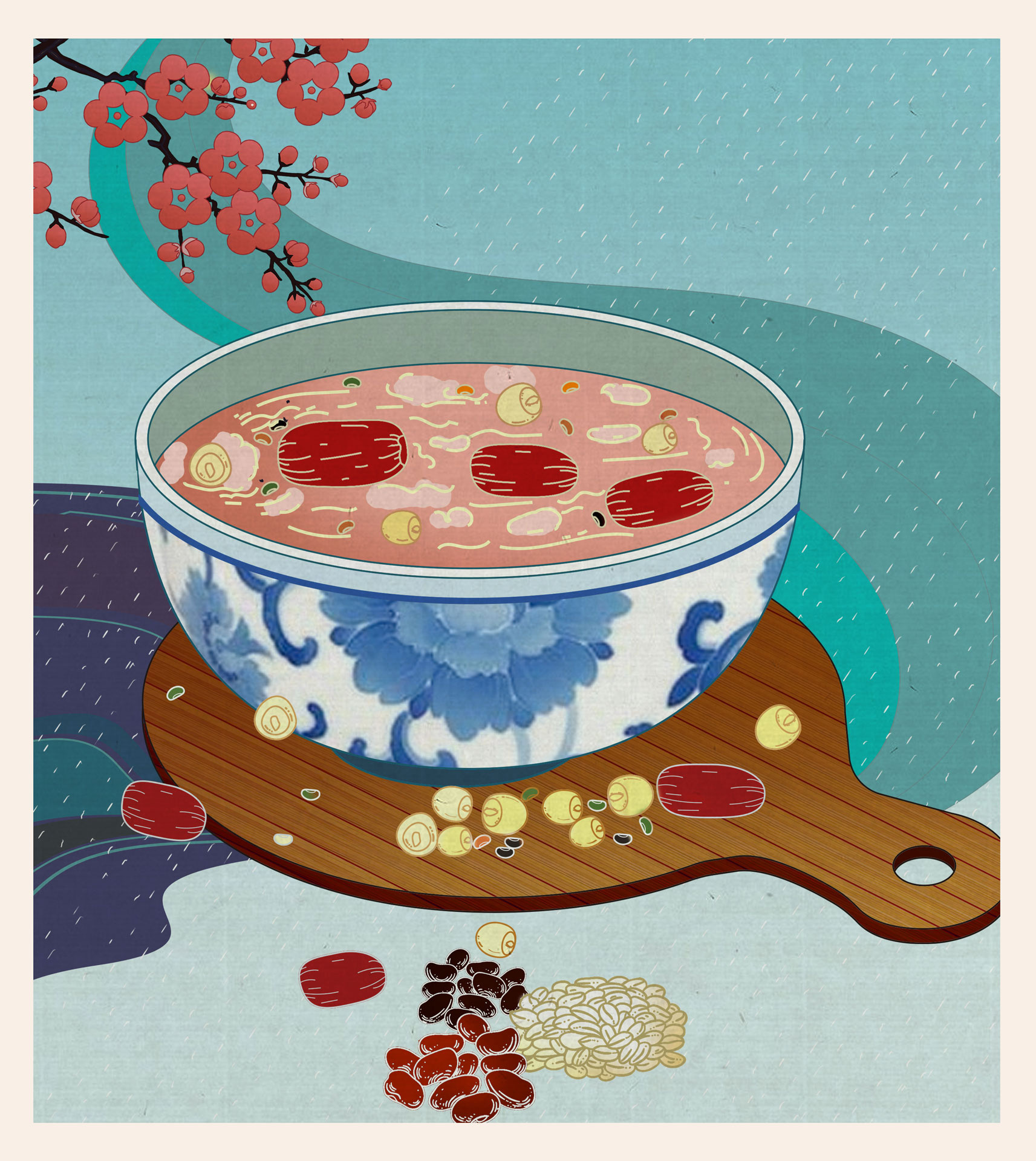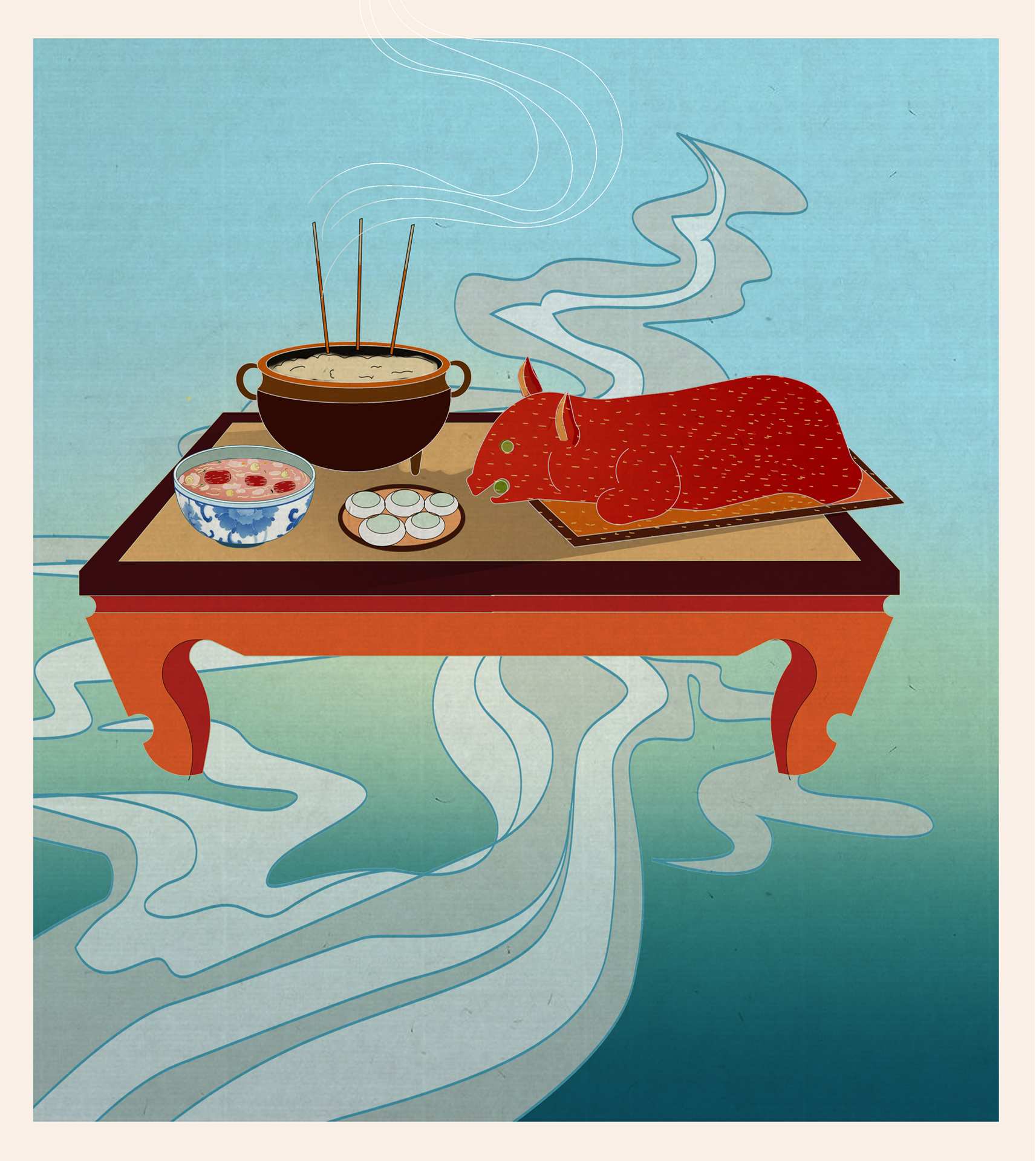

What is the Laba Festival?
Thursday marks the traditional Laba Festival in China. Laba Festival, also simply called "Laba," comes on the eighth day of the twelfth month of the Chinese lunar year. The festival has this name because the twelfth month is also called "la" month in Chinese while the number eight is pronounced "ba."
Since it's in the last month of the lunar year, the festival implies saying goodbye to the old and embracing the new, and often regarded as a warm-up celebration for the upcoming Spring Festival.

A picture of the offerings on Laba Festival. /Graphic design by Li Yueyun
Laba Day is also Bodhi Day in the Buddhist tradition. It's said that Shakyamuni Buddha, the founder of Buddhism, attained enlightenment on this day. Thus, the day is one of the grandest festivals for Buddhists.
What do we do on this day?
One of the festival's traditions is to offer sacrifices to the ancestors and gods. In the agrarian societies of ancient times, this worship was a prayer for good luck and a bountiful harvest.
It was also an important ritual for emperors in those times, who would hold grand sacrificial fetes in the winter to show their appreciation to nature and their ancestors.

A picture of Laba congee. /Graphic design by Li Yueyun
Those ancient activities could be interpreted as a reflection of "Xiao" (filial piety), "Ren" (benevolence and love) and “Yi” (righteousness) in Confucian values.
Nowadays, the rituals tend to be less formal. People offer sacrifice now more to memorialize family members who have passed away. Those who visit temples on this day are not necessarily religious believers, but want to demonstrate their best wishes for the Chinese New Year.
What food do we eat for this fest?
The tradition to have Laba congee on this day dates back more than a thousand years and is still a major part of Laba day in many places.
Legend has it that, before being enlightened, the Buddha worked hard for many years and was emaciated and weak. Thanks to the milk porridge offered by some shepherdesses, he recovered physical strength and later achieved enlightenment.

A picture of Laba garlic. /Graphic design by Li Yueyun
Therefore, nowadays, temples adhere to the tradition of offering congee to the public on this day to show appreciation for the kindhearted and to help the poor.
The selection of ingredients for the congee may vary geographically, but generally it include grains like rice, millet, glutinous rice, sorghum, black rice, and coix seeds; beans like soybean, red bean, mung bean, kidney bean, and cowpea; nuts like red dates, peanuts, lotus seeds, goji, chestnuts, raisins, walnuts, and longans.
In northern China, it's also popular to make Laba garlic. People usually put peeled garlic cloves into a container with vinegar and then seal it up. During the pickling process, the garlic will turn green. It is a typical side dish to have with dumplings during the Spring Festival.
In northwest China, some residents in Shaanxi Province eat Laba noodles for the festival. People in Qinghai Province and Ningxia Hui Autonomous Region prefer rice made with beans or meat. In places like Anhui in east China, people will eat Laba tofu.
These local customs vary based on location and climate and are intended to help people overcome the winter cold and prevent illness.

 Award-winning photos show poverty reduction achievements in NE China's Jilin province
Award-winning photos show poverty reduction achievements in NE China's Jilin province People dance to greet advent of New Year in Ameiqituo Town, Guizhou
People dance to greet advent of New Year in Ameiqituo Town, Guizhou Fire brigade in Shanghai holds group wedding
Fire brigade in Shanghai holds group wedding Tourists enjoy ice sculptures in Datan Town, north China
Tourists enjoy ice sculptures in Datan Town, north China Sunset scenery of Dayan Pagoda in Xi'an
Sunset scenery of Dayan Pagoda in Xi'an Tourists have fun at scenic spot in Nanlong Town, NW China
Tourists have fun at scenic spot in Nanlong Town, NW China Harbin attracts tourists by making best use of ice in winter
Harbin attracts tourists by making best use of ice in winter In pics: FIS Alpine Ski Women's World Cup Slalom
In pics: FIS Alpine Ski Women's World Cup Slalom Black-necked cranes rest at reservoir in Lhunzhub County, Lhasa
Black-necked cranes rest at reservoir in Lhunzhub County, Lhasa China's FAST telescope will be available to foreign scientists in April
China's FAST telescope will be available to foreign scientists in April